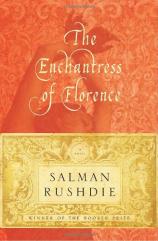The Enchantress of Florence
Review
The Enchantress of Florence
In
THE ENCHANTRESS OF FLORENCE, his 11th work of fiction, Salman
Rushdie has given the breath of life to a world completely alien to
our own, and yet, in distinctive ways, rooted in a reality possible
for us to recognize. Rushdie is a master teller of tales, and the
seductiveness of this delightful work, which blends characters from
the historical to the fantastic, is certain to burnish that
reputation.
The novel opens in the late 16th century, when a yellow-haired
character in a multicolored coat, calling himself Mogor
dell’Amore, appears in Fatehpur Sikri, the gleaming capital
city of the Mughal Empire, ruled by Akbar the Great, a descendant
of Genghis Khan and Timur the Lame (Tamerlane). Akbar is in many
ways a strikingly modern man, questioning the existence of God and
presiding over spirited debates in the Tent of the New Worship
between competing philosophical schools --- the Water Drinkers,
religious thinkers and mystics, and the Wine Lovers, philosophers
and scientists. And yet this same rationalist skeptic has created
an imaginary queen named Jodha, to whom he’s more devoted
than any of the dozens of beautiful wives who comprise his
harem.
The Mogor, bearing a stolen letter containing credentials as the
ambassador of England’s Queen Elizabeth I, describes himself
as “a man with a secret…a secret which only the
emperor’s ears may hear.” Woven through the balance of
the novel, the storyteller (born Niccolò Vespucci) unveils
that secret, narrating the mysterious, enthralling tale of the
devastatingly beautiful Qara Köz (Lady Black Eyes), the
enchantress of the novel's title, and her companion, the Mirror.
Born into the Persian Empire, Qara Köz is captured by Antonino
Argalia, a Florentine soldier of fortune now in the service of the
Ottoman Turks. Argalia's boyhood friends include the starkly
realistic political philosopher Niccolò Machiavelli and
Agostino Vespucci, cousin of the New World explorer, Amerigo.
Argalia returns with his gorgeous prize to Florence, and when Qara
Köz and the Mirror arrive, Rushdie tells, in a typical example
of the lavish description with which the novel is suffused, how
“their faces shone with the light of revelation, as though in
those early days of their unveiling they were capable of sucking
light in from the eyes of all who looked upon them and then
flinging it out again as their own personal brilliance, with
mesmeric, fantasy-inducing effects.” Argalia assumes the role
of condottiere of the city, chosen by the ruling Medici
family to protect its interests in the myriad political and
religious conflicts of the early Renaissance. Qara Köz, now
known as Angelica, captivates the citizens of Florence, and it
appears a golden age is at hand. But when the Medici ruler, Lorenzo
II, dies suddenly and under mysterious circumstances, the
Florentines suspect their cherished enchantress has practiced
witchcraft to bring about his death and drive her into exile.
Rushdie’s tale overflows with fantastic characters and
amazing stories: a court painter named Dashwanth who literally
paints himself into a portrait, or a “glowing lake”
that “looked like a sea of molten gold” transformed
into a “muddy hollow where once…sweet water had
glistened” in a matter of days. There are magic potions and
spells, like the “Great Uzbeg Anti-Shiite Potato and Sturgeon
Curse,” albino giants, witches, heroes and cowards,
scoundrels and fools. There’s even a gruesome account of a
battle between Argalia’s Ottoman forces and the army of Vlad
the Impaler, the cruel ruler on whose life the tale of Dracula is
based.
Alongside these vivid creations of Rushdie’s imagination are
well-known historical figures like Akbar and Machiavelli, and
lesser-known ones like the Italian warlord Andrea Doria. As much as
THE ENCHANTRESS OF FLORENCE is infused with striking characters and
lavishly spun tales, Rushdie also toys with big ideas: the
relations between men and women, the cultural encounter between
East and West, the uses of political power and the struggle between
modernity and tradition.
The novel is multilayered and complex, and there’s some
degree of patience required at times to absorb all the characters
and place names tossed into the bubbling stew. It’s probably
not a bad idea to have an historical resource close by when
reading. Indeed, Rushdie lists more than four pages of works he
consulted in researching this book.
“The story was completely untrue,” one of
Rushdie’s characters notes, “but the untruth of untrue
stories could sometimes be of service in the real world.”
Those words might serve as a suitable epigraph for a work that is
itself so enchanting and teeming with life.
Reviewed by Harvey Freedenberg (mwn52@aol.com) on January 21, 2011
The Enchantress of Florence
- Publication Date: May 27, 2008
- Genres: Fiction
- Hardcover: 368 pages
- Publisher: Random House
- ISBN-10: 0375504338
- ISBN-13: 9780375504334





